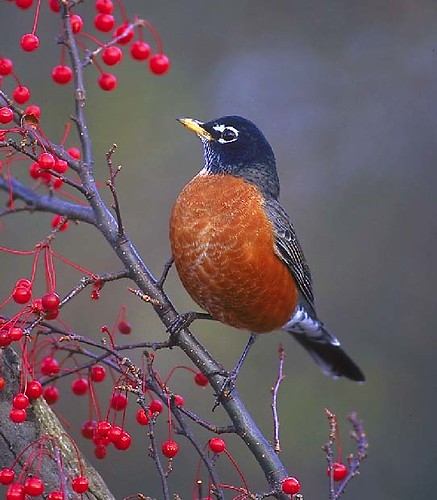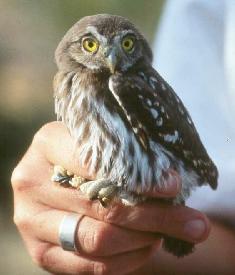Birds in the News #21

American Robin, Turdus migratorius
Lang Elliott, NatureSound Studio (1998)
Birds in Science:
In last week's Birds in the News, I linked to a news story reporting on birds that sing with their wings, but like all good things, this story is worth repeating, and I linked to a nicely-written article. National Public Radio also has a report about the courtship sounds of the manakins, including sound files of their songs.
The beloved American robin, Turdus migratorius, not the annoying, raucous American crow, Corvus brachyrhynchos, may be the source of West Nile virus, according to new research. A DNA analysis of blood taken from the abdomens of 300 mosquitoes trapped in Connecticut over the past three years found that 40 percent fed on the blood of the red-breasted songbird and only 1 percent on crows, said Theodore Andreadis, chief medical entomologist at the Connecticut Agricultural Experiment Station. This research was published in the peer-reviewed journal, Emerging Infectious Diseases. Also take a peek at West Nile Virus myths and facts. GrrlScientist note: this makes sense since crows were basically falling dead from the sky not too long ago as a result of this disease. The lethality of West Nile virus for crows and other corvids suggested that the birds would die too quickly to effectively transmit the disease, so the reservoir must be another species that was only mildly affected.
In another beautiful example of evolution and natural selection, the crested auklet, Aethia cristatella, a bird species found in some parts of Western Alaska is believed to emit a natural mosquito repellent with properties similar to DEET, the key ingredient in many commercial repellents. "It was literally like stepping into a Dr. Seuss story," Hector Douglas, a University of Alaska Fairbanks researcher, said. "The birds would come down and have this citrus smell and they're landing on the rocks all around you and they have these elaborate social interactions. It was pretty peculiar, the first time it happened." These findings, which are part of Douglas's doctoral thesis, are published in the Journal of Medical Entomology.
Avian Rediscoveries:
A team from Asociacion Armonía (BirdLife in Bolivia) saw one and heard three more Southern helmeted curassows, Crax unicornis koepckeae, in the Sira mountains of central Peru; the first time the distinctive endemic Peruvian race of this Endangered species has been seen since 1969. The team hopes to develop a long-term conservation project in the Sira mountains, to continue their awareness work, educate local people about sustainable use of natural resources, and hire a team of park guards. The team will return to the area this October, thanks to a grant from Sweden's Club 300.
Ivory-Billed Woodpecker News:
In a sort of ecological trade-off, conservationists headed into the Arkansas woods Thursday to kill dozens of trees in hopes of helping the ivory-billed woodpecker, a bird that up until recently was feared extinct. The woodpecker feasts on beetle larvae beneath the bark of dead trees. Killing trees by damaging the bark or administering herbicide could create more food for them and help the species recover. "The goal really is to see if we can induce some kind of decrepitness in these trees, attract the insects and ultimately see if the woodpecker would use the trees," said Douglas Zollner, who works with The Nature Conservancy and is one of the project directors.
Birds Needing Help:
Over half of globally important tropical Andean wildlife sites remain unprotected, according to a book published by BirdLife International and Conservation International. This book, Important Bird Areas in the Tropical Andes, identifies 455 sites that cover 17% of the region's total land area, of these, 250 (55%) are unprotected.
Bird Mysteries:
A top federal wildlife official says the pelican mystery at the Chase Lake National Wildlife Refuge may be a natural correction. Nearly 30,000 white pelicans abandoned the refuge last year, leaving eggs and chicks behind. This year, refuge officials estimated about 8,000 young white pelicans died during the spring and early summer nesting period, and more adults left. Senator Byron Dorgan, D-N.D., said there may be some plausible reason for the pelican exodus, but he wants to make sure the pelicans are not "sort of a canary in a mine shaft, signaling a larger problem that needs more attention." GrrlScientist comment: I find this "top wildlife official's" conclusion to be absolutely astonishing. I think the senator is doing the right thing in this case because birds do not abandon their nests and chicks without good cause.
Is this just one freak year? Or is this global warming? Marine biologists are seeing mysterious and disturbing things along the Pacific Coast this year: higher water temperatures, plummeting catches of fish, lots of dead birds on the beaches, and perhaps most worrisome, very little plankton -- the tiny organisms that are a vital link in the ocean food chain. "There are strange things happening, but we don't really understand how all the pieces fit together," said Jane Lubchenco, a zoologist and climate change expert at Oregon State University. "It's hard to say whether any single event is just an anomaly or a real indication of something serious happening."
People Helping Birds:
This short story tells how drunken wood pigeons, Columba palumbus, also known as kereru in New Zealand, wreak havoc. But most stayed in an avian "de-tox" center for a couple of days before being returned to the spot where they were found. "This is important because they have partners and families," said Robyn Webb from the Whangarei Native Bird Rescue Centre.
The Ecuadorian Minister of the Environment has signed a decree putting into effect a conservation strategy for the Great Green Macaw, Ara ambigua. The Great Green Macaw is classified as Endangered and numbers fewer than 2,500 individuals in Central and South America, with just 60-90 individuals of the western Ecuadorian guayaquilensis race known, in the Esmeraldas and Guayas Provinces.
People Hurting Birds:
More than half a million European birds will be at risk as they soar along Bulgaria’s Northern Black Sea Coast on migration after Dolores Arsenova, the Bulgarian Minister of Environment and Water, gave the go-ahead for three wind-farm developments at Cape Kaliakra, a BirdLife-designated Important Bird Area. "More than 500,000 soaring birds — pelicans, cranes, buzzards, eagles, and storks — will be at risk when they face a whirling wall of death. This is Europe’s second largest soaring bird migration route and these birds come from all over northern Europe; Bulgaria has an international obligation to protect them," said Dr. Nikolai Petkov, Director of Conservation at BSPB/BirdLife Bulgaria, who has lodged an appeal against approval of the project.
European zoo authorities plan to set up an international database to register animals that are being stolen in growing numbers to feed demand from private collectors and unscrupulous dealers in the exotic pet trade. “What makes me angry is not the financial loss but the damage to the animals,” said Michel Louis, owner of the Amneville Zoo in northeast France. “It is so much easier to nick a parrot in a French zoo – and it’s a lot cheaper to carry off. No plane ticket, no intermediaries, no one to bribe. And the collectors are more and more numerous with more and more exotic demands.”
Avian Influenza News:
Declining public health funding could intensify a global pandemic of avian influenza. Short of cash, and unable to compete with private biotechnology companies, the California Department of Health Services is often unable to replace microbiologists who retire. "The status of public health in California has diminished drastically in the past two decades," said Alameda County Public Health Officer Dr. Anthony Iton. "We've gotten away with it only because we haven't had a major public health crisis since AIDS."
Russia's Siberian region of Novosibirsk said on Tuesday it will slaughter 65,000 birds in 13 locations as more cases were confirmed on Tuesday of a strain of bird flu dangerous to humans. "It has been decided to slaughter all hens, ducks, geese and turkeys at farms where the virus had been detected. The farms' owners will be paid compensation for all the birds that are killed and provided with safe poultry meat and eggs at a discount price," a Novosibirsk administration spokeswoman said.
While Alfred Hitchcock's The Birds made many of us uneasy at the sight of amassing gulls years ago, today public health officials around the world are beginning to cast an equally uneasy eye toward migratory birds, especially in Alaska, following recent outbreaks of avian influenza in Southeast Asia and, last week, in Siberia. This is due to warnings from Kevin Winker, curator of birds at the University of Alaska Museum of the North and an associate professor of biology at UAF. "Before I came nobody was paying attention to the extensive overlap between the Old World and New World migration systems as a disease pathway," said Winker. GrrlScientist note: the "amassing birds" in Hitchcock's political allegory were a variety of corvid, gull and pigeon species.
This article lists is an interesting chronology of avian influenza: Key dates in Asian bird flu outbreak.
Streaming Birds:
This week on BirdNote, the featured birds this week include the male Mallard, Anas platyrhynchos, in molt; Glaucous-winged Gulls, Larus glaucescens, nesting on rooftops; the Brown Creeper, Certhia americana; young Bald Eagles, Haliaeetus leucocephalus; and birds on the beach. Each story is two minutes long and is available as an RSS/PodCast Feed.
Miscellaneous Bird News:
Can "bugs" capture and eat birds? This is a short story about a hummingbird that was killed by a preying mantis. It includes pictures.
 The U.S. Fish and Wildlife Service announced that it will propose the removal of the cactus ferruginous pygmy owl, Glaucidium brasilianum cactorum, in Arizona from the list of threatened and endangered species. The wildlife service listed the pygmy owls as endangered in 1997, followed by the agency's 2002 proposed designation of 1.2 million acres (480,000 hectares) in Arizona as critical habitat. Ruling on a 2001 lawsuit filed by homebuilding groups, the San Francisco-based 9th U.S. Circuit of Appeals ruled in 2003 that the agency had not justified its listing of the owls as significant when considered separately from a broader population that includes owls in areas along Mexico's western coast. There are currently only 20 of these owls, with five nests between them, living in the disputed area. Public comments must be received by the USFWS by October 3. Send comments to;
The U.S. Fish and Wildlife Service announced that it will propose the removal of the cactus ferruginous pygmy owl, Glaucidium brasilianum cactorum, in Arizona from the list of threatened and endangered species. The wildlife service listed the pygmy owls as endangered in 1997, followed by the agency's 2002 proposed designation of 1.2 million acres (480,000 hectares) in Arizona as critical habitat. Ruling on a 2001 lawsuit filed by homebuilding groups, the San Francisco-based 9th U.S. Circuit of Appeals ruled in 2003 that the agency had not justified its listing of the owls as significant when considered separately from a broader population that includes owls in areas along Mexico's western coast. There are currently only 20 of these owls, with five nests between them, living in the disputed area. Public comments must be received by the USFWS by October 3. Send comments to;- Field Supervisor
U.S. Fish and Wildlife Service
Arizona Ecological Services Field Office
2321 West Royal Palm Road, Suite 103
Phoenix, Arizona 85021-4951
Written comments may also be sent by facsimile to 602/242-2513
FOR FURTHER INFORMATION CONTACT: Steve Spangle, Field Supervisor, telephone 602/242-0210; facsimile 602/242-2513.

Thanks to my bird pals Ian, Ellen, Ron, Mike, and Robin for some of the links you are enjoying here. Also, many thanks to this week's fact checker, Ian, and to a Birds in the News financial contributor, Thomas.
Previous : : Birds in the News : : Next
Academic Job News: none, yet. The department chair is back and the negotiations will likely occur soon.
© 2004, 2005, 2006 by GrrlScientist











8 Peer Reviews:
"annoying, raucous crow"????? "&%#(*$@!!! journalist" more like it!
I've never seen goodie two-shoes robins "sledding" on the wind! They're too busy being "beloved" to do anything as undignified as play!
And don't ask me about the time someone said to me that crows "cause" WNV. I think he's still picking the shards of my words out of his skin.
Hmmpphh!!
Corax; I agree with your opinions about corvids and also regarding the source of WNV. I probably should not have quoted the news story so carefully. As a parrot companion -- and we all know that parrots are "opinionated", just like corvids -- I find loudness and cleverness often are correlated, at least in birds.
GrrlScientist
Do you think this correlation is also true for home sapiens?
The avian flu bit is rather alarming. Quesion: is that a self-portrait of you with a crow??
Tabor; no, the correlation doesn't hold for people: I think it's the quiet peeps we need to watch out for!
Joseph; I was so surprised when I first saw that picture because it does look rather like me, if I chopped my hair off. But it's a publicity still of Tippi Hedren, the star in Hitchcock's movie, The Birds. They don't say what the bird's name is, unfortunately.
GrrlScientist
How do guava berries ferment in the pigeons' crop? I didn't know fermentation could occur so quickly . . .
oh, and anyone know of research on West Nile and parrots? I'm thinking of putting up an outdoor aviary so my macaw can go outside on occassion, but I'm a bit anxious about WNV.
Jamie; the berries are already fermenting before the birds eat them.
Regarding WNV in parrots .. there isn't much research directed specifically at psittacines, but it is known that parrots can become ill with the virus, although this is not as common as one might think (Parrots are not as susceptible to WNV as corvids).
By the way, keeping outdoor aviaries safe from WNV-carrying mosquitos is a discussion I have had many times with my avicultural and zoo friends. You might want to call the curator of birds at your local zoo to find out what they do to keep their birds safe. But perhaps the best sort of outdoor aviary to build for birds is one where you can place screening outside of the wire mesh during mosquito season to prevent insect pests from getting at the birds. If you plan well, you could make this screening removable/reusable.
The real problem is for zoos and private collectors who keep corvids; WNV kills them incredibly quickly.
GrrlScientist
Post a Comment
<< Home